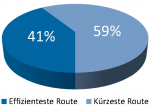Table of Contents
Mobile Navigation System for Electric Vehicles
eNav
The project eNav of the Embedded Software Laboratory at the RWTH Aachen University integrates diverse methods and ideas associated with embedded systems. The motivation is to determine the capacity of the accumulator in a more precise manner and to improve the utilization of the energy consumption. Furthermore, the project reveals barriers which can be avoided after on. The observations can be transferred to research of other electric vehicles like e.g. Pedelecs, Segway and so on.
eNav for a better future
Idea
The main idea of eNav is caused by the lack of support of navigation system for wheelchair users. There are some issues that should be addressed in this special case. A convenient navigation system is not able to determine if a route is too steep or if the remaining capacity of the accumulator is sufficient to reach the destination. Based on the project Rollstuhlrouting, the idea arose to implement a navigation system. The lack of a precise and reliable display of the accumulator capacity, lead to the motivation to design a system that improves the accumulator capacity. Additionally, new technologies are essential to calculate a route based on topographical characteristics. Finally, the user is able to choose between the shortest and the most efficient route.
Project
The project is divided into two parts. The first part covers the hardware attached to the electric wheelchair. Based on experience, most visualizations of the accumulator level are inaccurate. To gain an improved display of the accumulator level, a hardware palatine with several sensors is installed. Further factors like the internal resistance of the accumulator assist to map the actual capacity. A module connected via Bluetooth sends measured data to a mobile device (Android, iOS, J2ME,..). The distribution to a mobile device has two reasons. Firstly, there is no need to access the integrated display of the electric wheelchair. Secondly, such data is essential to the other part of the eNav project. The second part deals with the implementation of a navigation system designed for wheelchair users. This navigation system is not limited to calculation of the shortest and fastest route, but it also calculates efficient routes with respect to incline and surface information. Additional influence factors will be evaluated in the future. Due to the knowledge about the current accumulator level, the algorithm determines, if the destination is within reach of the user. If there is not enough energy, the user will be warned to avoid being trapped in the wheelchair.
Contribution
Chronik
| Year | Progress |
|---|---|
| 2010 | Development of a hardware board to quantify the energy consumption |
| 2011 | Development of a navigation system for electric wheelchairs |
| 2012 | Involvement of incline information available in OpenStreetMap (Weakness: incomplete and inaccurate) |
| Enrichment of OSM data by laser scan data (complete, deviation about 10cm) | |
| 2013 | Integration of surface information and improvement of the consumption function |
| Evaluation of the eNav system | |
| 2014 | Development of a new barrier-free GUI |
Status
The status of the eNav project depends on the collaboration with student workers and the results of the involved thesis. At the moment, the integration of surface information is finished. Due to restrictions because of copyrights, those information are only available for research purposes. In parallel, a thesis covers the implementation of a new user interface.
Help constucting a new generation of driving assistants!!!
eNav provides almost unlimited expandability and an entrance to different research fields. Students of electrical engineering and physics can assist by improving the consumption function and observing the behavior of the accumulator. Students of computer science and mathematics are required to improve the algorithms and the implementation of the software. Students of other faculties can help as well, e.g. by applying knowledge in the field of human computer interaction (HMI).
Contact
If you are interested in joining our group of researchers, please contact:
